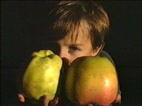 |
HOME lescrets fruits et pomologie Site personnel d'information à caractère non commercial et gratuit - Free personal site of information to non commercial character |
|||||
GREFFER LES ARBRES FRUITIERS
Grafting fruit trees
Time to graft Relation stock/scion Grafting wax
shield budding Whip-Grafting Cleft Grafting
Cleft Grafting
Cleft-grafting. This method of grafting is the most common and the easiest to perform. A branch between r and ill inches in diameter is cut with a pruning saw, care being taken not to loosen or tear the bark on the stub. If the saw is coarse the stub may be dressed with a sharp knife, which will tend to hasten the callousing. A grafting tool may be made by any local blacksmith from an old file, and will be found more serviceable than the other forms now on the market. The important characteristics of this tool are the heavy, curved blade, sharpened on the inner side, and the wedge on the end, placed well away from the back of the blade. The curved blade prevents the unnecessary loosening of the bark in making the cleft, and therefore is better than a straight blade. The stub is split with this tool just enough to accommodate the scions. The cleft is then held open with the small wedge, and two trimmed scions are placed in the cleft. Each scion should contain about three buds, and the lower end of the scion should
be trimmed with a sharp knife to a wedge about i or 11 inches long, with the outer edge of the wedge thicker than the other. It is very important that the sides of this wedge be cut perfectly even, and since the union of the scion and stock takes place at the cambium layer or inner bark, it is also important that the inner bark of the scion come in contact with the inner bark of the stock. Hence the scion is left a little thicker on the outside edge to insure a pressure of the stock against the scion at this point.

Fig. 180 Cleft-grafting
Frequently the scion is tipped slightly outward to bring the cambium layers into contact at one point at least. In preparing the scion it is also advisable to trim it in such a manner as to have a bud just above the wedge on the thicker side, so that when it is placed in the stock it will appear just above the cleft on the outside. After the scions are trimmed and placed in the stock, the wedged end of the grafting tool may be released from the cleft and the graft waxed.
If both the grafts grow, the weaker one should be cut out the following spring to prevent the formation of a crotch, and the stub, if not entirely healed, may be again covered with wax.